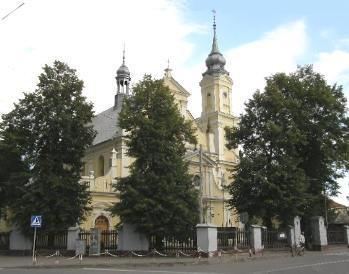Gmina Szczucin Local time Tuesday 3:53 AM | Population 4,069 Area 6.85 km² | |
 | ||
Weather 9°C, Wind NE at 8 km/h, 80% Humidity | ||
Szczucin [ˈʂt͡ʂut͡ɕin] is a town in Dąbrowa County, Lesser Poland Voivodeship, in southern Poland. It is the seat of the gmina (administrative district) called Gmina Szczucin. It lies approximately 16 kilometres (10 mi) north-east of Dąbrowa Tarnowska, 30 km (19 mi) north of Tarnów and 85 km (53 mi) east of the regional capital Kraków. The town has a population of 4,069.
Contents
Map of Szczucin, Poland
Before Polish administrative reorganization (1999) Szczucin was part of Tarnów Voivodeship (1975–1998). Located on the Vistula river, Szczucin is the ending station of a secondary-importance, one track rail line Tarnów - Dąbrowa Tarnowska - Szczucin, built by the Austrian government in 1906. There were several plans to extend the line northwards, to Busko Zdroj and Kielce, but so far, they have not been carried out. Current shape of the line is the result of Szczucin’s having been located until 1918 on northern border of Austria-Hungary. The Vistula marked the border, beyond which stretched the Russian Empire, and the governments of both countries were not interested in completion of the line, which would otherwise have connected Austrian-controlled Tarnów with Russian-controlled Kielce.
The town is placed along National Road nr. 73 (Warszawa - Kielce - Tarnów - Jasło), and here regional road nr. 982 stems eastwards, to Mielec, making Szczucin a local transportation hub. The name of the town probably comes from a 14-th century owner of the location, a man named Szczuka.
History
First mention of Szczucin (then known as Sucin, later Sczucin) comes from 1326, and it refers to a local parish church, which means that it must have been built earlier. Due to town’s location on the Vistula, a river port was established here. Timber from the forests of Sandomierz Wilderness was brought here, loaded on ships and hauled to Gdańsk, the biggest port of the Kingdom of Poland. Furthermore, Szczucin was a crossing point of the Vistula, along a north-south merchant trail. In 1780 the village obtained town rights, but in 1934 it lost them, as its population fell below the then required 3,000. Szczucin regained its town rights on 1 January 2009.
After the Partitions of Poland, Szczucin found itself on the Austrian - Russian border, and the town stagnated. In the autumn of 1914, during World War I, Szczucin was captured by the Russians, who remained here until 1915 (see Gorlice–Tarnów Offensive). In September 1939 Szczucin was the area of several skirmishes between retreating units of Kraków Army, and the advancing Wehrmacht. On September 12, 1939, German soldiers carried out a massacre of Polish POWs, who were kept at a local school. Altogether, 70 soldiers were killed, and this tragedy is commemorated by a monument. During the occupation, Szczucin was a center of resistance movement. In 1943, soldiers of Jędrusie executed here an officer of the Blue Police. In late 1944, Germans ordered evacuation of all Szczucin’s inhabitants, because they prepared defensive positions along the Vistula.
Szczucin is home to Poland’s only Road Museum (Muzeum Drogownictwa), which has the area of two hectares, displaying ancient road building machines, as well as road signs, road posts, documents and other items.
